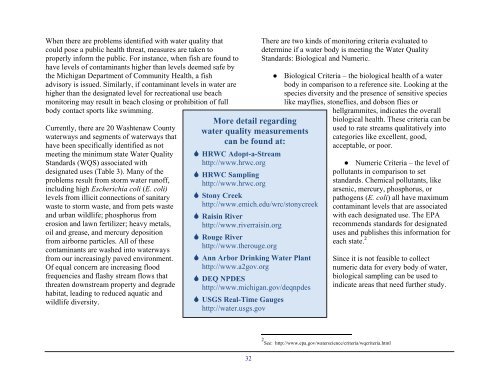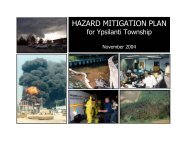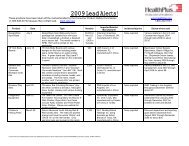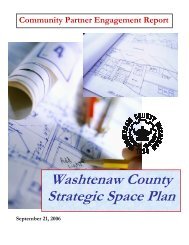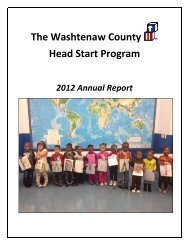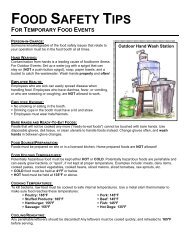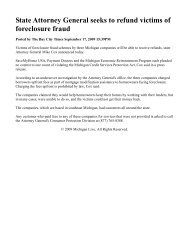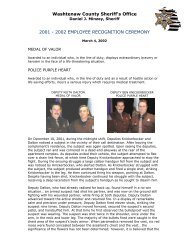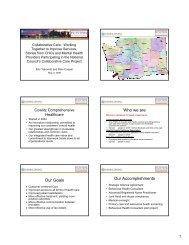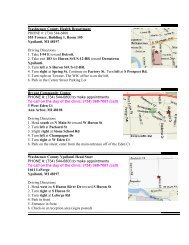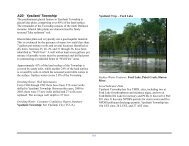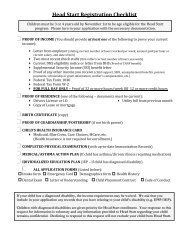Water Protection Activities in Washtenaw County
Water Protection Activities in Washtenaw County
Water Protection Activities in Washtenaw County
You also want an ePaper? Increase the reach of your titles
YUMPU automatically turns print PDFs into web optimized ePapers that Google loves.
When there are problems identified with water quality that<br />
could pose a public health threat, measures are taken to<br />
properly <strong>in</strong>form the public. For <strong>in</strong>stance, when fish are found to<br />
have levels of contam<strong>in</strong>ants higher than levels deemed safe by<br />
the Michigan Department of Community Health, a fish<br />
advisory is issued. Similarly, if contam<strong>in</strong>ant levels <strong>in</strong> water are<br />
higher than the designated level for recreational use beach<br />
monitor<strong>in</strong>g may result <strong>in</strong> beach clos<strong>in</strong>g or prohibition of full<br />
body contact sports like swimm<strong>in</strong>g.<br />
Currently, there are 20 <strong>Washtenaw</strong> <strong>County</strong><br />
waterways and segments of waterways that<br />
have been specifically identified as not<br />
meet<strong>in</strong>g the m<strong>in</strong>imum state <strong>Water</strong> Quality<br />
Standards (WQS) associated with<br />
designated uses (Table 3). Many of the<br />
problems result from storm water runoff,<br />
<strong>in</strong>clud<strong>in</strong>g high Escherichia coli (E. coli)<br />
levels from illicit connections of sanitary<br />
waste to storm waste, and from pets waste<br />
and urban wildlife; phosphorus from<br />
erosion and lawn fertilizer; heavy metals,<br />
oil and grease, and mercury deposition<br />
from airborne particles. All of these<br />
contam<strong>in</strong>ants are washed <strong>in</strong>to waterways<br />
from our <strong>in</strong>creas<strong>in</strong>gly paved environment.<br />
Of equal concern are <strong>in</strong>creas<strong>in</strong>g flood<br />
frequencies and flashy stream flows that<br />
threaten downstream property and degrade<br />
habitat, lead<strong>in</strong>g to reduced aquatic and<br />
wildlife diversity.<br />
More detail regard<strong>in</strong>g<br />
water quality measurements<br />
can be found at:<br />
HRWC Adopt-a-Stream<br />
http://www.hrwc.org<br />
HRWC Sampl<strong>in</strong>g<br />
http://www.hrwc.org<br />
Stony Creek<br />
http://www.emich.edu/wrc/stonycreek<br />
Rais<strong>in</strong> River<br />
http://www.riverrais<strong>in</strong>.org<br />
Rouge River<br />
http://www.therouge.org<br />
Ann Arbor Dr<strong>in</strong>k<strong>in</strong>g <strong>Water</strong> Plant<br />
http://www.a2gov.org<br />
DEQ NPDES<br />
http://www.michigan.gov/deqnpdes<br />
USGS Real-Time Gauges<br />
http://water.usgs.gov<br />
32<br />
There are two k<strong>in</strong>ds of monitor<strong>in</strong>g criteria evaluated to<br />
determ<strong>in</strong>e if a water body is meet<strong>in</strong>g the <strong>Water</strong> Quality<br />
Standards: Biological and Numeric.<br />
● Biological Criteria – the biological health of a water<br />
body <strong>in</strong> comparison to a reference site. Look<strong>in</strong>g at the<br />
species diversity and the presence of sensitive species<br />
like mayflies, stoneflies, and dobson flies or<br />
hellgrammites, <strong>in</strong>dicates the overall<br />
biological health. These criteria can be<br />
used to rate streams qualitatively <strong>in</strong>to<br />
categories like excellent, good,<br />
acceptable, or poor.<br />
● Numeric Criteria – the level of<br />
pollutants <strong>in</strong> comparison to set<br />
standards. Chemical pollutants, like<br />
arsenic, mercury, phosphorus, or<br />
pathogens (E. coli) all have maximum<br />
contam<strong>in</strong>ant levels that are associated<br />
with each designated use. The EPA<br />
recommends standards for designated<br />
uses and publishes this <strong>in</strong>formation for<br />
each state. 2<br />
S<strong>in</strong>ce it is not feasible to collect<br />
numeric data for every body of water,<br />
biological sampl<strong>in</strong>g can be used to<br />
<strong>in</strong>dicate areas that need further study.<br />
2 See: http://www.epa.gov/waterscience/criteria/wqcriteria.html


